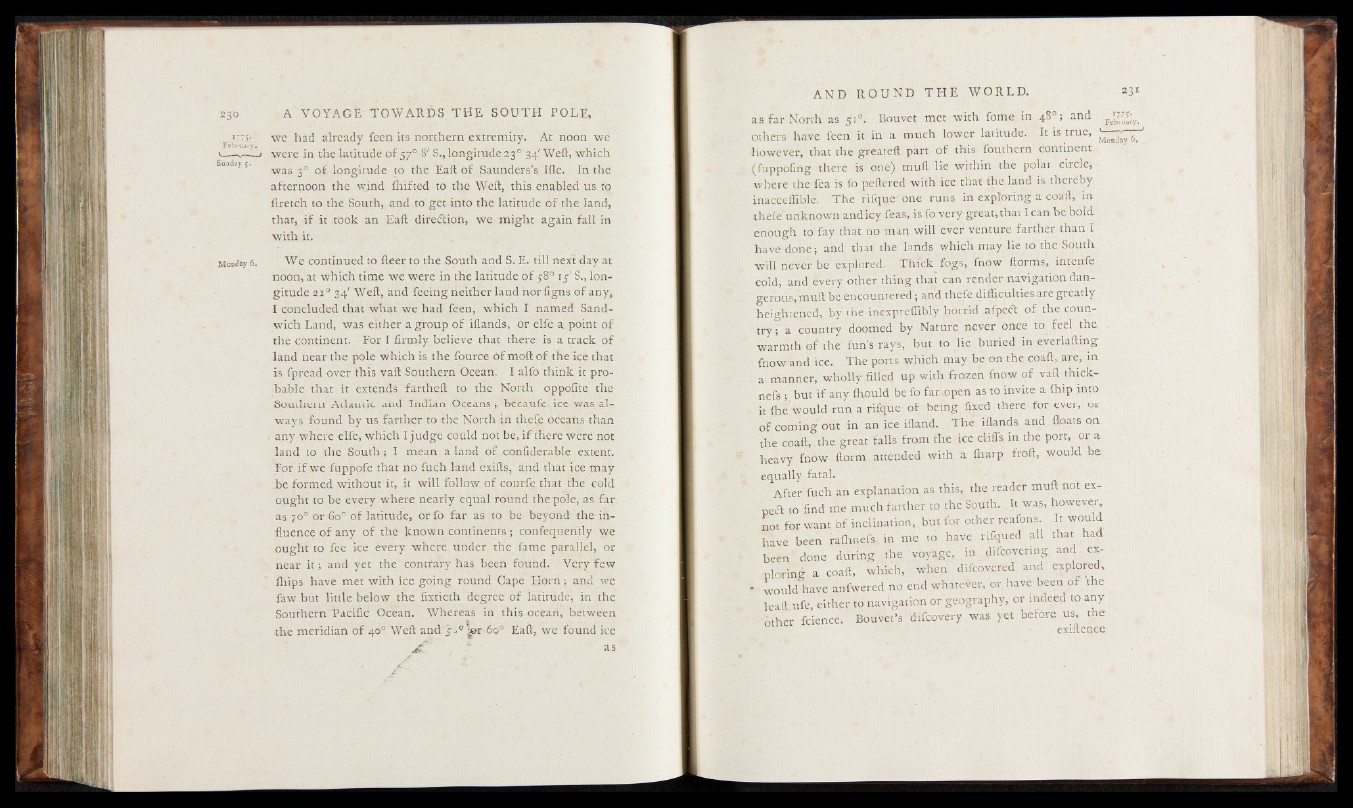
Monday 6.
we had already feen its northern extremity. At noon wé
were in the latitude of 570 8' S., longitude 23°'34'Weft, which
was 30 of longitude to the Eaft of Saunders’s Ifle. In the
afternoon the wind fhifted to the Weft, this enabled us to
ftretch to the South, and to get into the latitude of the land,
that, if it took an Eaft direction, we might again fall in
with it.
We continued to fleer to the South and S. E. till next day at
noon, at which time we were in the latitude of 58° 15' S., longitude
ai° 34' Weft, and feeing neither land norfigns Of any,
I concluded that What we had feen, which I named Sandwich
Land, was either a group of iflands, or elfe a point of
the continent. For I firmly believe that there is a track of
land near the pole which is the fource Of moft of the ice that
is fpread over this vaft Southern Ocean. I alfo think it probable
that it extends fartheft to the North oppofite the
Southern Atlantic and Indian Oceans ; becaufe ice was always
found by us farther to the North in thefe oceans than
I any where elfe, which I judge could not be, if there were not
land to the South ; I mean a land of confiderable extent.
For if we fuppofe that no fuch land exifts, and that ice may
.be formed without it, it will follow of courfe that the cold
ought to be every where nearly equal round the pole, as far.
as yo° or 6o° of latitude, or fo far as to be beyond the influence
of any of the known continents ; confequently we
ought to fee ice every where under the fame parallel, or
near it; and yet the contrary has been found. Very few
fhips have met with ice going round Cape Horn ; and we
faw but little below the fixtieth degree of latitude, in the
Southern Pacific Ocean. Whereas in this ocean, between
the meridian of 40° Weft and j^ °^ r 6o° Eaft, we found ice
? a,s
as far North as 51«* Bouvet met with fome in 489; and
others have feen it in a much lower latitude. It is true, jT
however, that the greateft part of this fouthern continent,
(fuppofing there is one) muft lie within the polar circle,
where the fea is fo peftered with ice that the land is thereby
inacceflible. The rifque* one runs, in exploring a coaft, in
thefe unknown andicy feas, is fo very great, that lean be bold,
enough to fay that no man will ever venture farther than I
have-done; and that the lands which may lie to the South
will never be explored. Thick fogs, fnow ftorms, intenfe
cold, and every other thing that can render navigation dangerous,
muft be encountered; and thefe difficulties are greatly
heightened, by the inexpreflibly horrid afpetff of the country
; a country doomed by Nature never once to feel the
warmth of the1 fun’s rays, but to lie buried in everlafting-
fnow and ice. The ports which may be on the coaft, are, in
j a manner, wholly filled up with frozen fnow of vaft thick-
nefs ;, but if any fhould be fo far open as to invite a fliip into-
it fhe would run a rifque of being fixed there forever, or
of coming' out in an ice ifland. The iflands and floats on
the coaft, the great falls from the ice cliffs in the port, or a
heavy fnow ftorm attended with a fliarp froft, would be
equally fatal. -
After fuch an explanation as this, the reader muft not expert
to find me much farther to the South. It was, however,
not for want of inclination, but for other reafons. It would
have been rafhnefs in me to have rifqued all that had
been, done during the voyage, in difeovenng. and exploring
a coaft, which, when difeovered and explored,
* would have anfwered no end whatever, or have been of the
leaft.ufe, either to navigation or geography, or indeed to any
other fcience. Bouvet’s difeovery was yet before us, the
- exiftence